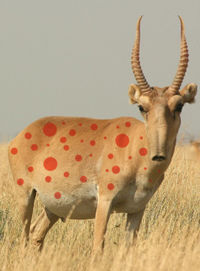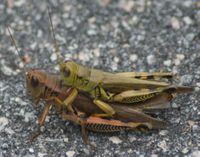Foreignesia
The Independent Democratic Republican Anarchy of Foreignesia is a small, obscure country located in a small crevice somewhere between Somalia and Greenland. Foreignesia is generally considered the world's least populace country with regards to total area, with only approximately 1,300 people in a country twice the size of Texas.
Foreignesia is an incredibly cold country with an average temperature of only 3 degrees Fahrenheit, with typical winter lows of over 100 degrees below zero and summer highs rarely exceeding 60 degrees. The southern and by far most populous region of Foreignesia has a subpolar climate not unlike that of Iceland, while the far northern reaches of the country, which pass well into the Arctic circle, experience an alpine tundra climate much like Antarctica. Foreignesia is located in an exceptionally mountainous region, with over 80 independent mountain ranges, and hosts the tallest peak on Earth, Mt. Toothache, at 29,030 feet and six contenders including Mt. Kisses, at 29,006 feet, and Mt. Dooley-Dooley at 28,875 feet. There are many lakes and moraines, legacies of the last glacial period, which ended about ten millennia ago, including the worlds deepest freshwater lake, Lake Bacacka, and the worlds smallest, an unnamed puddle found in an indentation upon a small pebble at the base of Mt. Hoodunnit and holding less than 2 milliliters of water.
As of late, Foreignnesia has three presidents, six kings, and a dictator, all named Toby, and all of them are dogs, mostly Dalmatians, with the exception of Kings Toby and Toby, who are sheep and President Toby, who is a pink balloon.
There is no immigration in Foreignesia due to strict quarantine laws and so the vast majority of the human population in the country are a fairly equal mixture of Russian, Scandinavian, and Brazillian people descended from just four babies who found themselves stranded in the Foreignese wilderness in 1969, the only survivors after a fixed-wing aircraft was brought down in a blizzard. According to legend, these babies were taken in by a motherly chipmunk who raised them alongside her own pups until they were old enough to be released back into the wild. The national language is unofficially Polish but Creole is equally spoken.
Demographics[edit | edit source]
The Foreignese people are a simple sort, thoroughly incapable of complex thought and living little more than 15 years. Up until 1997, farming was not known in the country and people made a living gathering the country's abundant lichens and tree bark. Nowadays most Foreignese are subsistence farmers, growing potatoes and ginger, with very few producing enough to survive, and clothing is unknown in all but the wealthiest regions of the country. The Foreignese people typically live in small ditches dug into the soil, but may also make house in abandoned badger burrows or tree hollows created by owls. The Foreignese people live at one with nature and typically do not eat meat, but only because they are too stupid to catch even the simplest of animals.
Economics[edit | edit source]
The Foreignese people are predominately self-sufficient, and import only bananas, which typically cannot be cultivated in the country due to the rocky soil and cool temperatures. Demand for the sweet yellow fruit is highest in wintertime, when the fields must lie fallow for the nineteen months of the year temperatures do not rise above freezing. Foreignesia's main exports include gravel and sticks. In particularly productive seasons the country may also export some of their potatoes, and according to experts, Foreignese-grown potatoes are among the most delicious in the world, right behind those from Vietnam.
Biodiversity[edit | edit source]
Foreignesia plays host to a tremendous number of animals, both furry and disgusting. By far the most common animal is the red-spotted tundra antelope, a large brown deer-like ungulate standing over five feet tall at the shoulder. Small herbivores include the humble arctic hare, the ferocious badger, and the elusive cow, and preying upon these animals include such bizzare predators as the little sabor-toothed mouse, the timidly violent white-lipped land catfish and the endangered polar bear. Foreignesia is the last country on Earth where one can still find lots of big and scary dinosaurs, which are still abundant in the boreal forest of the east, and also hosts the largest population of panda bears, with an estimated 6 million living in the bamboo groves of the southwest. Once abundant, lions are now very rare in Foreignesia, with only approximately 40 animals remaining, but their cousins the tigers, some so fluffy they resemble throw pillows, are very numerous and grow larger here than anywhere else on Earth, with some attaining weights of 3,000 pounds due to abundant prey including moose, horses, yaks, and rhinoceros.
Foreignesia has more bird species than both Canada and Alaska combined, with over 4 species, including miniature parasitic flamingos with black and yellow feathers and ducks so big they resemble Volkswagens. These ducks, known in the native language as wieczerza, meaning "supper", live in small herds throughout the country most anywhere near permanent water and eat both grass and fishes like the icky little carp. Living in similar habitat is also the red bafflebird, which unlike the duck is neither large nor placid but rather tiny and ferocious like a weasel. The bafflebird preys on animals as large as elephants, pecking out their eyeballs with sharp, chiseling beaks to gain entry to the inside of the head, where it lays its eggs to mature on the prey's nutritious brain. The adults, however, eat mainly fruit and nectar from native honeysuckle bushes. Other birds include over 80,000,000 species of small finches, all virtually identical and all but two pale brown in color (the other two are medium to dark brown in color), eleven kinds of turkey, some almost as big as a bus and others smaller than a matchbox, over 50 different flightless, vegetarian eagles, a rare white feathered peacock no bigger than a teacup, and 6 distinct species of purple owls that eat only on small type of frog that makes its home in volcanic pools and eats newts, which eat toads, which eat fleas which bite dogs which eat rabbits that eat grass that gets energy from sunlight.
With the exception of the flesh-eating bumblebee scorpion wasp, the gold-spotted butterfly and the venomous rape cricket, there are no insects in Foreignesia but there are over 650,000 species of crabs, some so small they cannot be seen with the naked eye but all deadly carnivores that attack their prey en masse. While there are 6 types of flight-capable sea clam and at least 7 breeds of arboreal squids, there is only one small lobster native to the island, the Tibetan monkey lobster. Growing only 7 feet long, this seclusive, furry scavenger holes up in its burrow during the day, emerging only at night to hunt small rodents on the taiga. Historically, there were at least nine other species, some so big they could be seen from space, but most all of these have long vanished during the last glacial recession.
There are few plants in Foreignesia due to the harsh climate, but mosses, lichens, and ferns are relatively common, as are small stunted shrubs, mostly willows and birch, and many millions of tons of red onions. Foreignesia is also home to the largest trees on earth and some little blueberry bushes that many animals like the squirrel depend on for survival. There is also a single pine tree growing on the Southernmost coast of the country and two small oak trees found in the West, with at least six small clumps of grass in the Southeast and two up North as well.

